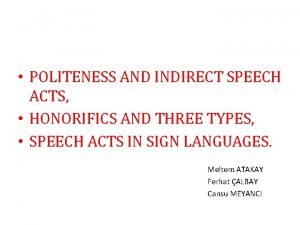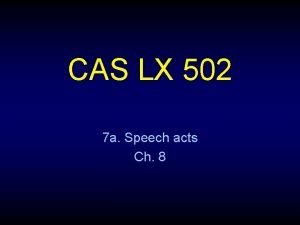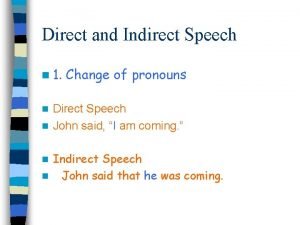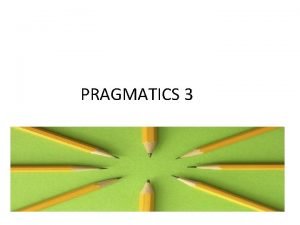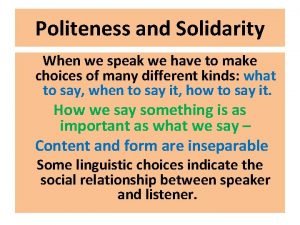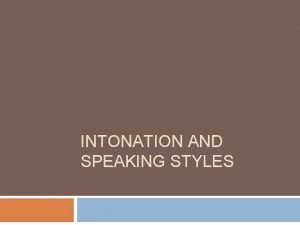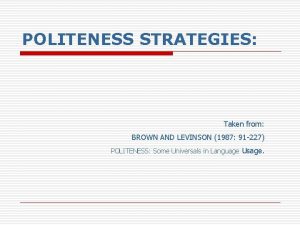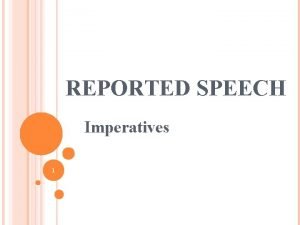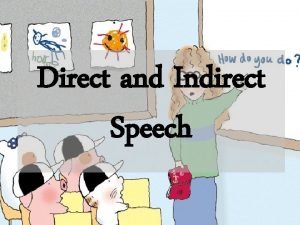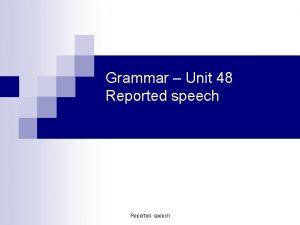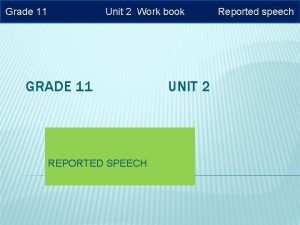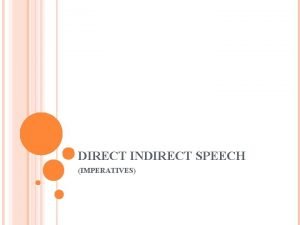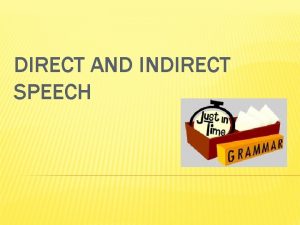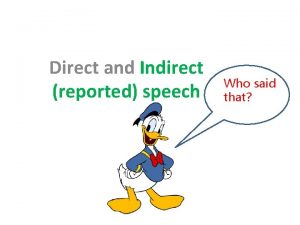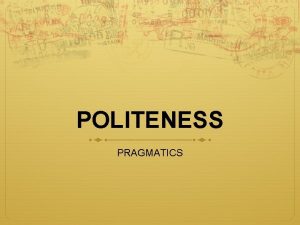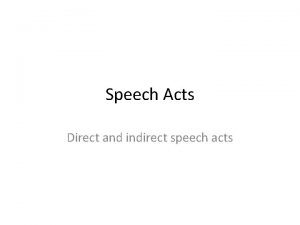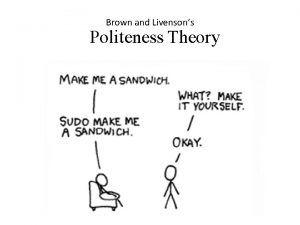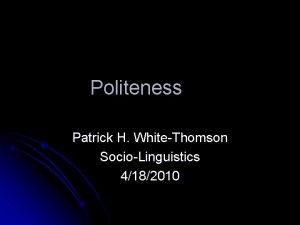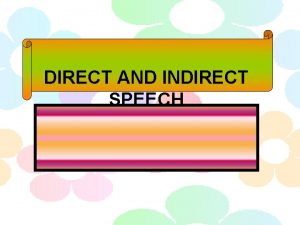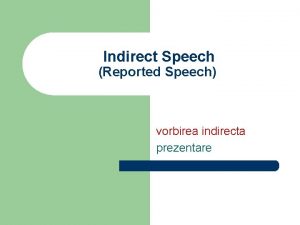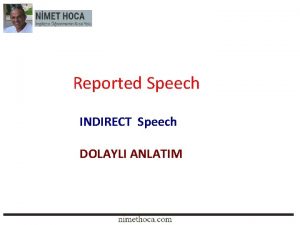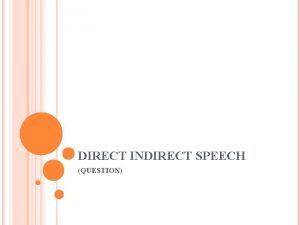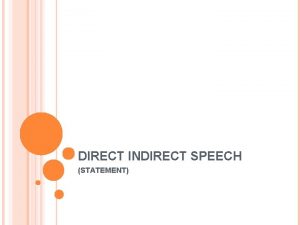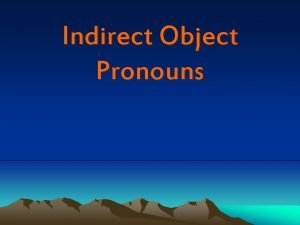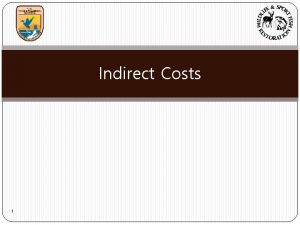POLITENESS AND INDIRECT SPEECH ACTS HONORIFICS AND THREE





































- Slides: 37

• POLITENESS AND INDIRECT SPEECH ACTS, • HONORIFICS AND THREE TYPES, • SPEECH ACTS IN SIGN LANGUAGES. Meltem ATAKAY Ferhat ÇALBAY Cansu MEYANCI

Politeness and indirect speech acts When people interact, identities and senses of selves are jostling for attention. • A central concept in pragmatics is the concept of face, that is, the public self-image that we all want to maintain.

• Face is something that is emotionally invested, and that can be lost, maintained, or enhanced, and must be constantly attended to in interaction (a term ultimately derived from the English expression ‘to lose face’).

• There are two aspects to the concept of face: 1 - The negative face, which basically denotes the need to be independent and free from imposition, 2 - The positive face, which, very simplified, denotes the need to belong and be accepted.

• to save someone’s negative face, If we want help from somebody, we might phrase the request with an initial face saving phrase, EXP: Excuse me, … or I’m sorry to bother you. . . * saving someone’s positive face, EXP: to increase the sense of group belonging.

• Politeness : It is a way of interaction which shows awareness of and respect for someone else’s face. • A face threatening act: It is an act that threatens the integrity and selfimage of another person. For example, giving someone a direct order such as, Sit down! and be quiet! implies having social power over that person.

• It is acceptable for a parent to give his or her child a direct order, but giving a direct order to your colleague or neighbour is in general a face threatening act and therefore not acceptable. Conversely, if we act or behave in a way that lessens a possible threat to another person’s face, we engage in a face saving act.

• One common strategy is to use an inclusive we, thereby reducing the request into a common act. Exp: ‘Should we sit down and continue? where the question removes the assumption of social power (for instance, by implying that the addressee has theoretical option to answer however he pleases) and therefore maintains the balance of face.

• There’s a fine balance to these kinds of strategies though: an inclusive we can very easily sound ironic and get a superior tone, thereby becoming a face threatening rather than face saving device.

• Face saving device: It is to use indirect speech acts to achieve our purposes. • In an indirect speech act the content of the utterance does not correspond to the speaker’s intention of the utterance. • The real purpose of the utterance is to get someone to do something for us (i. e. it is an indirect command)

• Misunderstanding between individuals and cultures when it comes to interpreting speech acts. What is polite for one person might not be for the other, and so on.

Indirect speech acts • Speech acts may be either direct or indirect. • In a direct speech act the content of the utterance matches the speaker’s intention of the utterance. • the declarative is simply a statement uttered with the purpose of giving information, • the interrogative is simply a question uttered with the purpose of getting information, • the imperative is simply a command with the purpose of getting someone to do something.

• A parent can pretty safely issue a direct command to his or her child while the child still lives at home. • A military commander can pretty safely issue a direct command to a soldier. There might be situations where close friends can give each other direct commands. But it is rarely useful for an employee to give a direct command to his or her boss, or for a host to order his or her guests about (or the guests the host, for that matter). * Therefore we engage in various politeness strategies.

• In indirect speech acts, we actually do not mean exactly what we say. EXP-1: Do you know where the library is? as a command (Tell me where the library is), Yes, thank you, I know where it is. * to use declaratives and interrogatives as politely disguised requests (or commands). *

as a conclusion • Giving someone a direct command, implies that we either have power over or are very intimate with that person. • Social situations involve complex structures of cooperation: we might want to achieve something, but we also have to take into account that we are surrounded by others whom we do not want to offend.

HONOROFICS: The linguistic politeness devices. 1. Referent Honorifics 2. Addressee Honorifics 3. Bystander Honorifics

Referent honorifics • The choice of linguistic form is dependent on what is referred to. • Binary distinction: Familiar vs Polite • For example, ‘tu/vous’ T/V pronouns refer to a single person in French distinction. • 49 of 207 languages use this binary distinction.

• Different levels of T/V pronouns: In German, the polite form Sie is the standard form of address. • In Swedish, the plural pronoun form ni is used to address a single person. • Multiple politeness distinction:

• ‘Pronoun Avoidance’ • Indonesian language: saudara: sibling, bapak: father, ibu: mother. • Pidgin and creole languages are similar to non -creoles with respect to politeness distinction in pronouns.

• Honorific distinction in the third person.

Addressee honorifics • The choice of the linguistic form is dependent on the addressee of the utterance.


• In Javanese language, the choice of vocabulary is addressee honorific. • Speech levels: ngoko (informal) madyô (semi-polite) krômô (polite) • Respect vocabulary: krômô inggél krômô andap

Bystander honorifics • The linguistic form of the language is dependent on who is within earshot of the utterance. • Taboo relatives


The ‘sideways language’ demands the suffix lawu on the noun (nguk ‘tobacco’) and the verb is inflected in the plural even though the utterance only has a single addressee.

SPEECH ACTS IN SIGN LANGUAGES 27

In Sign Languages: 1. Declaratives 2. Interrogatives 3. Imperatives Negative Declaratives • Negative Particles: Independent from signs. • Negative Intonation: Non-manual negative markers. 28

Non-manual Negatives: 1. Head Movements 1. 1 A repeated side-to-side head shake 1. 2 A single side-ward head turn 1. 3 A backward tilt of the head 2. Facial Expressions 2. 1 Negative mimics 29

Irregular Negatives: Negations in non-standard ways : Have small number : Not Indepedent BSL (Sign Language: UK) Evalution: NOT. GOOD; NOT. POSSIBLE Cognition: NOT. KNOW; NOT. UNDERSTAND Emotional attitude: NOT. WANT; NOT. LIKE; NOT. AGREE; NOT. BELIEVE Possession and Existentials: NOT. HAVE; NOT. EXIST Tense and aspect: WILL. NOT; NOT. FINISHED 30

31

In Regular Negatives; Indo-Pakistani Sign Language (IPSL) neg BOOK THIS INTERESTING NOT ‘This book is not interesting. ’ In Irregular Negatives; South Korean Sign Language neg WAY NOT-KNOW ‘I don’t know the way. ’ 32

Interrogatives in Sign Languages: • Polar Questions: Yes – No Questions : Almost all SL have : With Non-manuals or Question Particles(Optional) • Content Questions: Wh- Questions : More than Polar Questions : With Non-manual and Question words, or Non-manuals only 33

In Polar Questions; TSL (Sign Language: Thailand) _____pol. q SMOKE INDEX 2? ‘Do you smoke? ’

In Content Questions; American Sign Language (ASL) wh. JOHN BUY YESTERDAY WHAT ‘What did John buy yesterday? ’ 35

Imperatives In Sign Languages; American Sign Language (ASL) NOW START EAT ‘Start eating now!’ Deleted Subject Frowning, Wrinckled nose • In Negative Imperatives; A Special Sign: DO. NOT! 36

THANK YOU FOR LISTENING. 37
 Indirect speech acts examples
Indirect speech acts examples Direct vs indirect speech acts
Direct vs indirect speech acts Indirect speech acts
Indirect speech acts Direct sentence indirect sentence
Direct sentence indirect sentence Reported speech wh questions
Reported speech wh questions Changing direct to reported speech
Changing direct to reported speech Conversation and preference structure
Conversation and preference structure What is politeness
What is politeness Where was confucius born
Where was confucius born Rising or falling intonation
Rising or falling intonation Bald-on-record
Bald-on-record Preventative facework
Preventative facework Roosevelt helped negotiate peace between russia and
Roosevelt helped negotiate peace between russia and Negative politeness examples
Negative politeness examples Negative politeness examples
Negative politeness examples Spanish politeness
Spanish politeness Politeness is to human nature what warmth is to wax
Politeness is to human nature what warmth is to wax Politeness principle
Politeness principle Face theory goffman
Face theory goffman Passion modifiers of human acts
Passion modifiers of human acts Expressive speech act
Expressive speech act Elisabeth did you watch the latest film
Elisabeth did you watch the latest film Indirect speech imperative
Indirect speech imperative Objectives of direct and indirect speech
Objectives of direct and indirect speech Direct and indirect speech
Direct and indirect speech Direct speech punctuation
Direct speech punctuation Split direct speech
Split direct speech Reported speech statements questions commands and requests
Reported speech statements questions commands and requests Reported speech agenda
Reported speech agenda Speech grade 11
Speech grade 11 Reported speech imperatives
Reported speech imperatives My iscsp
My iscsp Imperative sentence direct to indirect
Imperative sentence direct to indirect What does indirect speech mean
What does indirect speech mean Reported speech present continuous
Reported speech present continuous Direct and indirect speech examples of simple present tense
Direct and indirect speech examples of simple present tense Speech act theory
Speech act theory Dore's primitive speech acts
Dore's primitive speech acts

